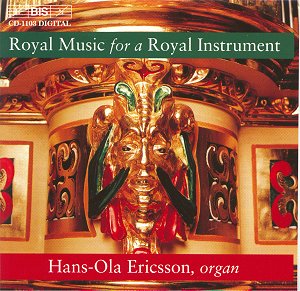ROYAL MUSIC FOR A ROYAL INSTRUMENT.
 The organ of Norrfjärden
Church, Sweden. Hans - Ola Ericsson (organ).
The organ of Norrfjärden
Church, Sweden. Hans - Ola Ericsson (organ).
 BISCD1103 [DDD] [62'
26"].
BISCD1103 [DDD] [62'
26"].

Andreas DÜBEN
Praeludium Pedaliter Wo Gott der Herr nicht
bei uns hält
Melchoir SCHILDT Gleichwie das Feuer Paduaria
Lachnymae
Gustav DÜBEN Suite in D
minor
A & M DÜBEN Allein Gott in der Höh sei
Ehr
Martin DÜBEN Praeluium Erstanden ist der heiley
Christ
ANONYMOUS Frantzösches
Liedelein
J.R. RADECK Engellischer Mascharada Courant.
Sarand
H. SCHEIDEMANN Englische Mascarada oder
Judentanz
M. DÜBEN Praembulum Pedaliter
G. DÜBEN (?) Nun lob, mein Seel, den Herren.
What is the reason for the apparent disinterest in organ music in so many
countries? Is it because the organ is predominantly associated with churches
and religion and that people nowadays object to the morality connected with
religion? I have received 'complaints' about 'moralising' in some of my musical
articles and reviews and this seems to support the view that moral truth
is seldom wanted.
It may be that organ recitals are usually in forbidding and unwelcoming churches
and other buildings which can be cold and uncomfortable. In addition,
church-going and morality is in decline perhaps due to the Church's lack
of a moral lead and being tarnished with secular things. All this may have
a bearing on the lack of interest in organ music.
But there may be other reasons. British organists during the Victorian and
Edwardian eras felt a compulsion to write for the king of instruments and,
quite frankly, a lot of it is very poor and often academically predictable.
The organ sonatas of Rheinberger enjoyed some popularity in the 1960s and
those of Gustav Merkel are being recorded.
In Britain there was the tendency to transcribe orchestral music for the
organ sometimes with disastrous results. Elgar wrote an organ sonata which
Gordon Jacob orchestrated to improve it. But there were some fine British
organists who wrote for their instruments ... William Wolstenholme, for example.
The organ used on this disc is a three manual instrument with pedals a
reconstruction in 1997 of the 1684 instrument in the German Church in Stockholm.
It has a lovely sound ... the flutes are exquisite and the 16 foot stops
on the pedals are very telling. It is an instrument of clarity and 'cleanness
of sound'.
The excellent booklet gives a full specification and registration for all
the pieces.
The music is mainly in the North German tradition of the 17th century and
is played with a very welcome elegance. And the sound is exemplary. The problem
is whether people want this unknown repertoire. None of the pieces were
remarkable although very pleasant to listen to. From an historical point
of view this disc is of great interest.
Strangely the most engaging piece is by that most prolific of early composers,
Anonymous! The Suite in D minor by Gustav Düben was very attractive.
But the real attraction is the organ itself with its wonderful sound and
a really fine executant.
Reviewer
David Wright
Performances

Recording

and Gerald Fenech adds
The powerful sound of this magnificent organ is indeed an imposing one. In
this virtuoso programme, Hans Ola Ericsson continues to confirm his reputation
as a fearsome exponent of such wonderfully sonorous instruments whilst unearthing
a few rarities that have lain undiscovered for centuries. An interesting
leitmotif on this disc is the contribution of the Duben family with no less
than three members producing works of excellent construction and fine melodic
content. Indeed, Andreas Duben's magisterial 'Praeludium Pedaliter' continues
to confirm the shameful neglect of such a talented composer. There is also
an effective Suite by Gustav Duben and short works by Martin Duben. Ericssona
also finds time for another obscure talent, Johann Rudolph Radeck whose Courant
Saraband is rather tuneful. I also enjoyed Melchior Schildt's 'Paduana Lachrymae
where the lower registers of the instrument are explored to an astonishing
degree. We can appreciate the beauty of this magnificent organ with the
stupendous sound that BIS manage to preserve. Ola Ericsson himself contributes
excellent and detailed notes on the organ, its history as well as a detailed
account of the Duben family association with the instrument for over a century.
Indeed the date of original construction of the Norrfjarden organ goes back
to 1609, and thus it is a treasure to be preserved. This outstanding disc
should serve to enhance its reputation especially after the laborious and
painstaking 1997 reconstruction.
Reviewer
Gerald Fenech
Performance:

Sound:


![]()